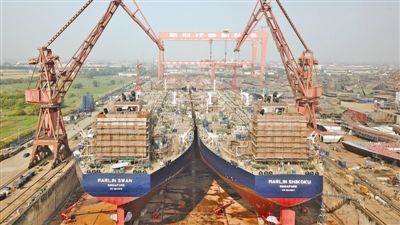Jiangmen shipyard: common causes of hull corrosion
1. Corrosion of hull structure on water
The part of the hull that is above water mainly includes deck, superstructure and freeboard. The above water parts of these ships are mainly affected by rain and snow, sea water spray and ocean atmosphere, and these factors are the important reasons for the severe corrosion of the hull on water. In the marine atmosphere, there are a lot of nitrogen compounds, which make the condensation water aggravate the damage to the hull structure.
On the other hand, the high temperature of the engine room and boiler in the deck also aggravates the water damage in these areas to a certain extent. Some scientific experiments show that the corrosion resistance of the pyrotechnics correction part in the hull is much lower than that in other parts of the hull because of the great change of the metal arrangement in the structure. Therefore, there is no good coating on the pyrotechnics correction part of the hull, and it is more simple and damaged than other parts, so that the corrosion rate of the hull is greatly accelerated.
2. Corrosion of hull structure under water
The underwater part of hull structure generally includes stern, bow, bottom and side. The ship's bow minister is always in the waves, and the director is always foaming. Seawater can produce strong hydrodynamic force on the hull of a ship, and the coating is usually severely damaged.

However, the hull on the side of the ship often causes serious damage to the surface coating of the ship's side when the ship is docked. The stern of hull structure is mainly made of copper alloy, especially at the end of hull, which can cause severe corrosion. The outer coating of hull is vulnerable to severe damage.
In addition, some floating objects in the sea may also cause severe damage to the hull coating. Moreover, if there are a lot of petroleum products on the sea surface of the hull site, these petroleum products will also cause severe damage to the external coating of the hull. This is because the coatings used in the waterline area are not stable, especially in petroleum products. In addition, the changing dry and wet conditions greatly increase the corrosivity of some corrosive media.
In addition, the welding parts of the underwater part of the hull structure are also corroded. The corrosion of the underwater part of the hull structure is usually electric corrosion.
3. Related corrosion in hull internal structure
Because of the different operating conditions of the hull, the internal compartments of different hull will also have different degrees of corrosion. For example, the corrosion degree of operation cabin and living cabin is generally light, and no obvious corrosion trace can be seen.
However, there will be severe corrosion in the sanitary cabin. In particular, the corrosion of bathroom, toilet and washroom is serious. In the cargo hold of the ship, because cargo is often loaded and unloaded, there are also water and condensation water, so the coating in the cargo hold structure is more simple to be damaged. In the future, the inner bottom plate and cargo tank wall of the ship will be corroded more quickly.
In addition, the corrosion of the tank in the hull is severe. However, due to the use of cement coating in ballast tank and fresh water tank, the cement coating is unstable and permeable, so it is difficult to restrain the corrosion of water tank. There is also a kind of corrosion in the hull, that is, electric corrosion. In general, the main reason for electric corrosion is that the hull is repaired in floating or installed at the wharf because the power supply line is not connected in the right way. As a result, stray currents will occur in the water where the hull is moored. This constitutes a more serious corrosion.
Source: Jiangmen shipyard http://www.zhongyucy.com/